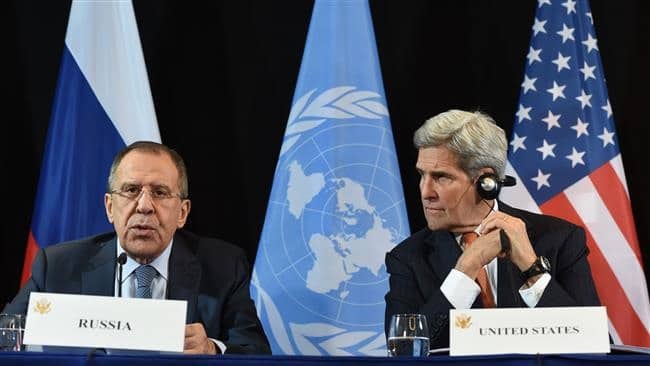
As co-chairs of the International Syria Support Group, the US and Russia announced yesterday an agreement on the “cessation of hostilities” in Syria that is scheduled to go into effect at midnight on February 27th. According to the agreement, the militaries of the US-led coalition, Russia, and Syria would at that point cease hostile acts against opposition groups not named in UN Security Council Resolution 2254 (ISIS and al-Qaeda’s Nusra Front) who “indicate to the Russian Federation or the United States…their commitment to and acceptance of the terms for the cessation of hostilities.”
In other words, opposition groups who agree to this deal and have not been named “terrorist” by the UN will not be targeted militarily and will in turn agree to stop trying to take territory by means of force. The US, Russia, Syria, and their allies have agreed to the same.
The Syrian government was not a party to the negotiations, but presumably the Russians have impressed upon Damascus the need to accept the agreement.
As to the changes on the ground one might logically foresee once the agreement is in place, it is difficult to see how much will change from the Russian perspective. Russia has claimed that it has concentrated its bombing campaign on ISIS and elements of al-Qaeda in Syria, and it has already reached out to cooperate with several moderate opposition groups. Russia contends that it will continue to bomb ISIS and Nusra unabated — permitted by the agreement — and both the ISIS “capital” Raqqa and the Nusra stronghold Aleppo are on the verge of liberation by the Syrian army with Russian backing.
The US, on the other hand, has as recently as the recent ASEAN conference in California at least implicitly restated its position that Syrian president Assad must be overthrown, as Obama put the blame for the destruction of Syria squarely on Assad and claimed no peace in Syria would be possible with Assad remaining in power. The US endgame in Syria if one accepts the letter of the agreement may be difficult to square, in that case, unless a radical shift in US policy takes place with the implementation of the ceasefire. The tide turning in the Syrian government’s favor is unlikely to be reversed through this agreement unless radically different interpretations emerge.
The always astute Moon of Alabama website believes it has gleaned some very important space for US maneuver in the wording of the agreement, which may suggest a future Rambouillet-like camel nose under the tent that will open the door for undermining the Russian position and perhaps pave the way for a Turk/Saudi-led ground invasion to achieve by blunt force what had been attempted unsuccessfully for five years thus far by proxy.
This room for re-interpretation is the highly suspect absence of the crucial phrase “and entities associated with Al Qaeda or ISIL” from yesterday’s agreement as compared to the UN Resolution authorizing military force in Syria. This means that while the UN Resolution recognized that innumerable groups — some larger, some smaller — have associated themselves with particularly al-Qaeda’s Nusra Front and are for all intents and purposes one and the same, today’s agreement does not explicitly recognize this fact, leaving space for the US side to claim that airstrikes on, for example, groups like Ahrar al-Sham and others by the Russians would be in violation of yesterday’s “cessation of hostilities” agreement.
Moon of Alabama puts a finer point on this critical difference:
Let us assume that Ahrar al-Sham agrees to the cessation of hostilities and follows its terms. The Syrian and Russian intelligence suddenly get good information about the location of the joint operations room of al-Nusra, Ahrar ash-Sham and Jund al-Aqsa.
Now would that joint operations room or headquarter be a legitimate bombing target under the cessation of hostilities agreement? In my view bombing it would obviously be allowed because al-Nusra/al-Qaeda is there. But the “moderate” terrorists, the U.S. and their other sponsors would scream bloody murder about such bombing.
Thus the poison pills may already be injected into yesterday’s agreement, leading some to believe the agreement may not last one full minute after implementation time.
Saudi Arabia has already thrown down the gauntlet, promising that Assad will be removed by force should peace talks fail. Will the Saudis be joined by the Turks, with whom they are currently sharing some Turkish airbases? Are reports true that NATO has warned Turkey that if it initiates an invasion of Syria, all Article 5 obligations will be deemed null and void?
This “cessation of hostilities” agreement thus raises more questions than it answers, and it begs the question as to whether the Russians believe the US is an honest partner in this effort, particularly in light of Washington’s ongoing duplicity over such issues as eastern Ukraine and NATO deployments on the Russian border. If reports are true that Russian president Putin has warned Turkey that a joint Turk-Saudi invasion of Syria that threatens the Russian military in situ may trigger the Russian use of a tactical nuclear device, the stakes may be higher than anyone even imagines. Let us hope the neocons are kept far away from the buttons of power in the weeks ahead.

